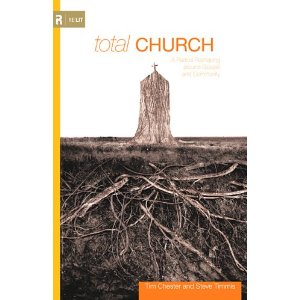 I had a friend in the ministry tell me, “I wish every pastor would have to read Total Church.” That should give this book on practical ecclesiology merit in its own right. I don’t know if I would go as far as to say that – but I can definitely see its usefulness for ministry team discussions and personal wrestling with ecclesiology.
I had a friend in the ministry tell me, “I wish every pastor would have to read Total Church.” That should give this book on practical ecclesiology merit in its own right. I don’t know if I would go as far as to say that – but I can definitely see its usefulness for ministry team discussions and personal wrestling with ecclesiology.
Timmis and Chester come from many years of pastoral and church planting ministry in the UK. That is what gives them credibility to write a book such as this. Their goal in writing is simple: how to be the church as a we – not an I – and how the gospel must shape that model.
The best part about this book is you almost have to engage it and think and process for this book to do you any good. They have designed it well that way; it is full of thought-provoking ideas.
The thing that is most difficult in this book is the UK slant. Yes, the church is the church is the church. But, the church will look different in different cultures. The examples from The Crowded House they use may not necessarily transfer to church in American culture – or in a non-Acts 29 church.
I think this book would best be read by 1) a ministry team in a local church. We just read through it as a ministry team at my church and we had good conversation on many aspects of this book and how we could incorpate/improve in many areas. 2) by a ministry student who is studying and then preparing to do full-time ministry. It is important to know and understand why you have the ecclesiology you hold to. If you don’t like multi-site, cell group, family integrated, seeker friendly, traditional SS model, etc – you should know why. You should definitely be able to articulute what is important to you in the life of a church. This book will help you clarify that belief.
“Where God’s Word is not heard, chaos and darkness close in again. God rules as his word is trusted and obeyed. God is rejected when his word is not trusted and not obeyed.” (p 25) I am so grateful to be in a church where the Word of God is clearly and passionately taught at every event I go to (whether singles events, youth training events, and most definitely the worship service on Sunday).
“Few Christians are going to object to being gospel-centered, just as no one is against mothers or apple pie. The problem is the gap between our rhetoric and the reality of our practice. The continual challenge for us is to apply this principle to church life and ministry without compromise.” (33)
“The UK (USA) will never be reached until we create open, authentic, learning and praying communities that are focused on making whole-life disciples who live and share the Gospel wherever they relate to people in their daily lives. We need non-full-time leaders who can model whole-life, gospel-centered, missional living. This means creating church cultures in which we see normal, celebrating day-to-day gospel living in the secular world and discussions of how we can use our daily routines for the gospel.” (37)
“God is at the center of the gospel word. Yet much evangelism tends to place people in that position. The gospel becomes skewed toward me and how Jesus meets my needs.” (55)
“We need to be communities of love. And we need to be seen to be communities of love. People need to encounter the church as a network of relationships rather than a meeting you attend or a place you enter.” (59) Based on some recent conversations, perception is reality – for those people. We need to always strive to be reaching out to people – whether they look like they have it all together or not. People need people.
“The best thing we can do for the poor is offer them a place of welcome and community. People are often unaware of how much the culture of their church is shaped by their social class. Someone at the door of a church, for example, may hand a newcomer a hymnbook, a Bible, service guide, or bulletin with a small and greeting without realizing how intimidating these can be to someone from a nonliterate culture. The social activities to which the poor are invited, the decision-making processes of teh church, the unwritten dress codes, the style of teaching can all be alien to the marginalized.” (81). We take the culture of our church for granted. Would the poor feel welcome in a upper-class church? Would a traditional person feel welcome in a Acts 29/modern church? It goes both ways. And we always need to be aware of people who may not look like us – to make them feel just as welcome and to care for them.
“We have a simple rule of thumb in our church: if we do this as a family, we can do it as a church; if we would not do this as a family, why do it as a church?” (190). Baptism and Lord’s Supper – two ordinances Scripture gives the church – not the family. Acts 2 – clearly evidenced in both. Children and Youth Ministry – how most churches operate – is there a place for those ministries in Total Church churches?
This book is thought-provoking. Read through it critically.

kimddavidson
Thank you. I’m glad you found it.